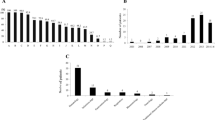Abstract
To identify the clinical features of lymphoma-associated hemophagocytic syndrome (LAHS), we retrospectively analyzed the clinical characteristics, laboratory findings and survival data of 16 LAHS patients from 69 adult hemophagocytic syndrome (HPS) patients. The results showed that the most common clinical manifestations and laboratory parameters were fever (100 %), ferritin ≥ 500 g/L (100 %), peripheral cytopenia in two or more lineages (100 %), fibrinogen (Fbg) < 1.5 g/L (93.8 %) and splenomegaly (81.3 %) in LAHS patients. The percentages of patients with Fbg < 1.5 g/L, PLT < 40 × 109/L and LDH ≥ 1,000 U/L in the LAHS group were significantly higher than those in non-LAHS patients (P = 0.010, 0.000, and 0.001, respectively). Survival analysis showed that HLH patients with rheumatological reasons had better prognosis (OS; median not reached), followed by patients in the infection group (350 days) and those with unexplained causes (140 days). LAHS had the worst prognosis (only 37 days). The symptoms of LAHS patients are usually confused with other HPS. Patients with LAHS had higher probabilities to have Fbg < 1.5 g/L, PLT < 40 × 109/L, LDH ≥ 1,000 U/L and poor prognosis, so early diagnosis and systemic treatments are required.

Similar content being viewed by others
References
Larroche C, Mouthon L. Pathogenesis of hemophagocytic syndrome (HPS). Autoimmun Rev. 2004;3(2):69–75.
Henter JI, Horne A, Arico M, Egeler RM, Filipovich AH, Imashuku S, et al. HLH-2004: diagnostic and therapeutic guidelines for hemophagocytic lymphohistiocytosis. Pediatr Blood Cancer. 2007;48(2):124–31.
Henter JI, Arico M, Egeler RM, Elinder G, Favara BE, Filipovich AH, et al. HLH-94: a treatment protocol for hemophagocytic lymphohistiocytosis. HLH study group of the histiocyte society. Med Pediatr Oncol. 1997;28(5):342–7.
Wang Y, Wang Z, Chen H, Wang X. Adult onset of primary hemophagocytic syndrome in subjects carrying PRF1 mutations. Ann Hematol. 2012;91(9):1489–90.
Fukaya S, Yasuda S, Hashimoto T, Oku K, Kataoka H, Horita T, et al. Clinical features of haemophagocytic syndrome in patients with systemic autoimmune diseases: analysis of 30 cases. Rheumatology (Oxford). 2008;47(11):1686–91.
Kuzmanova SI. The macrophage activation syndrome: a new entity, a potentially fatal complication of rheumatic disorders. Folia Med (Plovdiv). 2005;47(1):21–5.
Falini B, Pileri S, De Solas I, Martelli MF, Mason DY, Delsol G, et al. Peripheral T-cell lymphoma associated with hemophagocytic syndrome. Blood. 1990;75(2):434–44.
Su IJ, Hsu YH, Lin MT, Cheng AL, Wang CH, Weiss LM. Epstein–Barr virus-containing T-cell lymphoma presents with hemophagocytic syndrome mimicking malignant histiocytosis. Cancer. 1993;72(6):2019–27.
Campo E, Swerdlow SH, Harris NL, Pileri S, Stein H, Jaffe ES. The 2008 WHO classification of lymphoid neoplasms and beyond: evolving concepts and practical applications. Blood. 2011;117(19):5019–32.
Cheson BD, Pfistner B, Juweid ME, Gascoyne RD, Specht L, Horning SJ, et al. Revised response criteria for malignant lymphoma. J Clin Oncol. 2007;25(5):579–86.
Farquhar JW, Claireaux AE. Familial haemophagocytic reticulosis. Arch Dis Child. 1952;27(136):519–25.
Schmid JP, Canioni D, Moshous D, Touzot F, Mahlaoui N, Hauck F, et al. Clinical similarities and differences of patients with X-linked lymphoproliferative syndrome type 1 (XLP-1/SAP deficiency) versus type 2 (XLP-2/XIAP deficiency). Blood. 2011;117(5):1522–9.
Stepensky P, Weintraub M, Yanir A, Revel-Vilk S, Krux F, Huck K, et al. IL-2-inducible T-cell kinase deficiency: clinical presentation and therapeutic approach. Haematologica. 2011;96(3):472–6.
Rigaud S, Fondanèche MC, Lambert N, Pasquier B, Mateo V, Soulas P, et al. XIAP deficiency in humans causes an X-linked lymphoproliferative syndrome. Nature. 2006;444(7115):110–4.
Seidel MG. CD27: a new player in the field of common variable immunodeficiency and EBV-associated lymphoproliferative disorder? J Allergy Clin Immunol. 2012;129(4):1175.
Van Montfrans JM, Hoepelman AI, Otto S, van Gijn M, van de Corput L, de Weger RA, et al. CD27 deficiency is associated with combined immunodeficiency and persistent symptomatic EBV viremia. J Allergy Clin Immunol. 2012;129(3):787–93.
Rouphael NG, Talati NJ, Vaughan C, Cunningham K, Moreira R, Gould C. Infections associated with haemophagocytic syndrome. Lancet Infect Dis. 2007;7(12):814–22.
Janka G, Imashuku S, Elinder G, Schneider M, Henter JI. Infection-and malignancy-associated hemophagocytic syndromes: secondary hemophagocytic lymphohistiocytosis. Hematol Oncol Clin N Am. 1998;12(2):435–44.
Lay JD, Tsao CJ, Chen JY, Kadin ME, Su IJ. Upregulation of tumor necrosis factor-alpha gene by Epstein–Barr virus and activation of macrophages in Epstein–Barr virus-infected T cells in the pathogenesis of hemophagocytic syndrome. J Clin Invest. 1997;100(8):1969–79.
Yu JT, Wang CY, Yang Y, Wang RC, Chang KH, Hwang WL, et al. Lymphoma-associated hemophagocytic lymphohistiocytosis: experience in adults from a single institution. Ann Hematol. 2013;92(11):1529–36.
Janka GE. Hemophagocytic syndromes. Blood Rev. 2007;21:245–53.
Chandrakasan S, Filipovich AH. Hemophagocytic lymphohistiocytosis: advances in pathophysiology, diagnosis, and treatment. J Pediatr. 2013;163(5):1253–9.
Arico M, Janka G, Fischer A, Henter JI, Blanche S, Elinder G, et al. Hemophagocytic lymphohistiocytosis. Report of 122 children from the International Registry. FHL Study Group of the Histiocyte Society. Leukemia. 1996;10(2):197–203.
Tong H, Ren Y, Liu H, Xiao F, Mai W, Meng H, et al. Clinical characteristics of T-cell lymphoma associated with hemophagocytic syndrome: comparison of T-cell lymphoma with and without hemophagocytic syndrome. Leuk Lymphoma. 2008;49(1):81–7.
Henter JI, Elinder G, Soder O, Ost A. Incidence in Sweden and clinical features of familial hemophagocytic lymphohistiocytosis. Acta Paediatr Scand. 1991;80(4):428–35.
Trottestam H, Horne A, Arico M, Egeler RM, Filipovich AH, Gadner H, et al. Chemoimmunotherapy for hemophagocytic lymphohistiocytosis: long-term results of the HLH-94 treatment protocol. Blood. 2011;118:4577–84.
Acknowledgments
The authors thank all of the doctors and nurses in the department of Hematology, Rheumatology, Infectious Department, Gastroenterology in The First Affiliated Hospital of Nanchang University.
Conflict of interests
The authors declare no conflict of interest.
Author information
Authors and Affiliations
Corresponding author
Rights and permissions
About this article
Cite this article
Li, F., Li, P., Zhang, R. et al. Identification of clinical features of lymphoma-associated hemophagocytic syndrome (LAHS): an analysis of 69 patients with hemophagocytic syndrome from a single-center in central region of China. Med Oncol 31, 902 (2014). https://doi.org/10.1007/s12032-014-0902-y
Received:
Accepted:
Published:
DOI: https://doi.org/10.1007/s12032-014-0902-y




